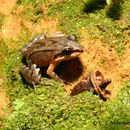en
names in breadcrumbs


Leptodactylus albilabris és una espècie de granota que viu a Puerto Rico, les Illes Verges Britàniques i les Illes Verges Nord-americanes.
Leptodactylus albilabris és una espècie de granota que viu a Puerto Rico, les Illes Verges Britàniques i les Illes Verges Nord-americanes.
Leptodactylus albilabris is a species of frog in the family Leptodactylidae.
Its local name is ranita de labio blanco or sapito de labio blanco ("white-lipped froglet") and English name either Gunther's white-lipped frog or Hispaniolan ditch frog.
It is found in the Dominican Republic on Hispaniola, Puerto Rico, the British Virgin Islands, and the U.S. Virgin Islands.[1][2]
The white-lipped frog is a terrestrial (living on the ground) smooth-bodied frog (not warty like a toad) which passes through a tadpole stage. The tadpoles are brown colored, reaching about 1.5 inches (38 millimeters) in length. L. albilabris can be recognized by its white upper lip (hence the name albilabris), webless fingers and toes, black streak between the eyes and the tip of the snout and between eye and shoulder. In general, adults grow to 1.4 inches (3.6 centimeters) in snout-vent length, but like other Puerto Rican frogs the body size increases with elevation and adults of a snout-vent length greater than 2.0 inches (5.1 centimeters) are not rare in the higher regions of the El Yunque National Forest. Individuals have a grayish brown background color with dorsal lines and bands of various shades of brown, cream, and reddish brown. It is white ventrally, and some males have many dark spots on the throat. Its voice is a "pink-pink-pink" sound usually heard from a muddy area.[3]
The frog's diet includes insects, millipedes and land snails. It lays terrestrial eggs, but they are laid in a foam nest on the ground, usually under a rock or log. Eggs develop into tadpoles, which are washed away by the first rains and finish their development in temporary pools, or bodies of water with low or no water movement.[3]
This frog can usually be found in muddy areas near streams, marshes and ditches.[3]
Leptodactylus albilabris is a species of frog in the family Leptodactylidae.
Leptodactylus dominicensis es una especie de ránidos de la familia Leptodactylidae.
Es endémica de la República Dominicana.
Se encuentra amenazada de extinción por la pérdida de su hábitat natural.
Leptodactylus dominicensis es una especie de ránidos de la familia Leptodactylidae.
Leptodactylus albilabris Leptodactylus generoko animalia da. Anfibioen barruko Leptodactylidae familian sailkatuta dago, Anura ordenan.
Leptodactylus albilabris Leptodactylus generoko animalia da. Anfibioen barruko Leptodactylidae familian sailkatuta dago, Anura ordenan.
Leptodactylus albilabris est une espèce d'amphibiens de la famille des Leptodactylidae[1].
Cette espèce se rencontre aux îles Vierges, à Puerto Rico et dans l'Est d'Hispaniola en République dominicaine[1],[2].
Son nom d'espèce, du latin, alba, « blanc », et labrum, « lèvre », lui a été donné en référence à la bande blanche présente au niveau de sa bouche[3].
Leptodactylus albilabris est une espèce d'amphibiens de la famille des Leptodactylidae.
Leptodactylus albilabris is een kikker uit de familie fluitkikkers (Leptodactylidae). De wetenschappelijke naam van de soort werd in 1859 als Cystignathus albilabris gepubliceerd door Albert Carl Lewis Gotthilf Günther.[2]
De soort komt voor in delen van Puerto Rico en zowel de Britse als de Amerikaanse Maagdeneilanden. De kikker leeft in moerassen, rivieren, bossen, tuinen en in plantages.[3]
Leptodactylus albilabris é uma espécie de anfíbio da família Leptodactylidae.
É endémica da República Dominicana.
Os seus habitats naturais são: pântanos, lagos de água doce intermitentes e áreas agrícolas temporariamente alagadas.[2]
Está ameaçada por perda de habitat.[2]
Leptodactylus albilabris é uma espécie de anfíbio da família Leptodactylidae.
É endémica da República Dominicana.
Os seus habitats naturais são: pântanos, lagos de água doce intermitentes e áreas agrícolas temporariamente alagadas.
Está ameaçada por perda de habitat.
Leptodactylus albilabris là một loài ếch trong họ Leptodactylidae. Tên gọi bản địa của nó là ranita de labio blanco hoặc ranite de labio blanco ("ếch nhỏ môi trắng"). Nó được tìm thấy ở Puerto Rico, quần đảo Virgin thuộc Anh, và quần đảo Virgin thuộc Mỹ. Các môi trường sống tự nhiên của chúng là các khu rừng ẩm ướt đất thấp nhiệt đới hoặc cận nhiệt đới, sông, đầm nước, đầm nước ngọt, các đồn điền, vườn nông thôn, các khu rừng trước đây bị suy thoái nặng nề, và đất có tưới tiêu.
Phương tiện liên quan tới Leptodactylus albilabris tại Wikimedia Commons
Leptodactylus albilabris là một loài ếch trong họ Leptodactylidae. Tên gọi bản địa của nó là ranita de labio blanco hoặc ranite de labio blanco ("ếch nhỏ môi trắng"). Nó được tìm thấy ở Puerto Rico, quần đảo Virgin thuộc Anh, và quần đảo Virgin thuộc Mỹ. Các môi trường sống tự nhiên của chúng là các khu rừng ẩm ướt đất thấp nhiệt đới hoặc cận nhiệt đới, sông, đầm nước, đầm nước ngọt, các đồn điền, vườn nông thôn, các khu rừng trước đây bị suy thoái nặng nề, và đất có tưới tiêu.